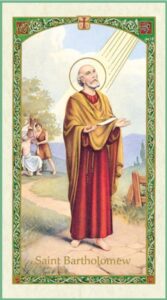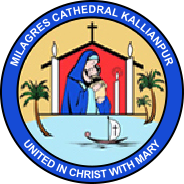“Saint Bartholomew, Apostle: Born at Cana. He was led to Jesus by the apostle Philip, and after the Lord’s Ascension tradition has it that he preached the gospel in India and there suffered martyrdom” (The Roman Breviary).

In Kallianpur on the banks of the Suvarna (Golden River) there exists a living and continuous tradition having roots in the hoary past and carried down by generations of locals and Christians that St Bartholomew, the Apostle of Jesus Christ, landed on its shores at Colmban or Colombe village at its ancient maritime port, adjacent to the Kallianpur Fort and its ancient temples, and preached the Faith. ‘Kalliana’ is land of joy and the suffix ‘pura’ indicates Fort. In that ancient period Kallianpur mentioned in ancient History marked the southern boundary of Ashoka’s empire on the Western Coast. The local tradition holds such details as St Bartholomew camped in the precincts of one of its temples close to the Fort and preached the Gospel by which the Hindu Deities and Purohits were disturbed and were unhappy.
It has, however, to be mentioned that no material evidence of this Christianity has so far been known to be found locally nor any efforts made in Kallianpur to unearth the evidence. But Rev. Fr H.O. Mascarenhas, M.A., Ph.D., D.D. of Goa researching in Rome and who in 1929 established the ‘Indian Society’ in the names of St Thomas and St Bartholomew for the benefit of the Indian students in Rome and who made a deep study of Apostolic Christianity in India from the documents in the Vatican and the original letters in Spanish of St Francis Xavier which he discovered in the Vatican Library, in his book, ‘Konkanachem Christaunponn’ (Christianity in Konkan) states, ‘In Tulunad in South Kanara, there is Kallianpur. Here Bartholomew, then popularly known as Bhethal, preached the Gospel’. He further states that there are many names of places words and usages in the coastal Konkan region going up to Bombay and beyond which have originated from his name Bhethal and his preaching and that Barkur which is close to Kallianpur sprang up after his name Bartholomew, i.e., Bar + Tulmai + Ooru = Barthooru-and so Barkuru. There is also the saying in Konkani, ‘‘Nagdo Bhethalo Xethak Vethalo Xetkaranc Udac Diun Ghara Vethalo’’, i.e., ‘the naked (fakir) Bhethal used to go to the fields, giving water to the farm labourers and return home.’ The water here is obviously the water of Baptism.
Many western writers and travellers of old have in their writings observed that in Kalliana there was Christianity in the early Christian era. Although some would suggest other places than Kallianpur for this name, Patriarch Ladislaus Zaleski, Apostolic Delegate of the East Indies who devoted thirty years of his life in India and who has to his credit thirty four published and unpublished works, mostly of research, has in his ‘Les Origines du Christianisme Aux Indes’ on page 39 has marked this Kallianpur as the place where the Apostle Bartholomew established a church and that there was a community of Christians. St Jerome (342-420A.D,) in his ‘De Viris Illustribus’ states that St Pantheneus found that the light of Faith taught by St Bartholomew was kept alive for 90 years with a Hebrew version of the Gospel of St Mathew. Again, Pauline de. S. Bartholomew in his India Orientalis Christiana, page 14, has said that in the sixth century, Kallianpur was an Episcopal See. Further, Cosmos Indicopleustes, a Greek traveller (later a monk at Sinai) who visited South East Asia between 520 and 525 A.D. and wrote his, ‘Christian Topography’ says that in the direction of (or into) the country Male (evidently meaning Malenad) where pepper is grown and in the place called Kalliana there is also a Bishop ordained from Persia (E.O. Windstedt. The Christian Topography of Cosmos Indicopleustes, Cambridge 1901, p.119). To some this has suggested places like Kalyan in Maharashtra and Quilon in Kerala to qualify for the ‘place called Kalliana’ mentioned by the traveller. But Quilon is an Anglicised name for Quollum and should not have pretensions for Kalliana either through accent or sound, nor Kalyan of Maharashtra could have any claims for being in or near the country of Male where pepper is grown. Kalliana sounds more Karnatic than Kalyan or Quollum. Obviously, it is Kallianpur where and in whose vicinity pepper is grown that qualifies for the honour. The fact of the Episcopal See in Kallianpur in the sixth century has, however, gained acceptance and it was therefore mentioned and highlighted at the reception accorded to the Bishops at the C.B.C.I. Conference held at Mangalore a few years ago.
It can be said that it was the knowledge of that earlier Christianity in Kallianpur that prompted and urged the Portuguese Hierarchy to establish again the Church in Kallianpur when it did in 1678 or they must have found clues or traces of it when they arrived here. The Church at Kallianpur which was rebuilt in 1806 by the Goan priests and which later was demolished in 1940 had Icons of St Thomas the Apostle and that of St Bartholomew on its facade on either side of the main entrance, evidently because of the tradition of St Bartholomew in the place. Msgr Denis Jerome D’Souza, who built the present church, saw to it that the tradition was carried forward. In the main body of the Church where the twelve Apostles of Christ are honoured with their statues all round the walls, that of St Bartholomew the Apostle of Kallianpur is prominently placed at the head of the apostles, nearest to the Sanctuary. Opposite to St Bartholomew is St Paul, the Apostle of the Gentiles, and by his side is placed St Thomas, the Apostle of India. These realities speak volumes of the unwritten tradition.
CHARLES E, G. LEWIS

